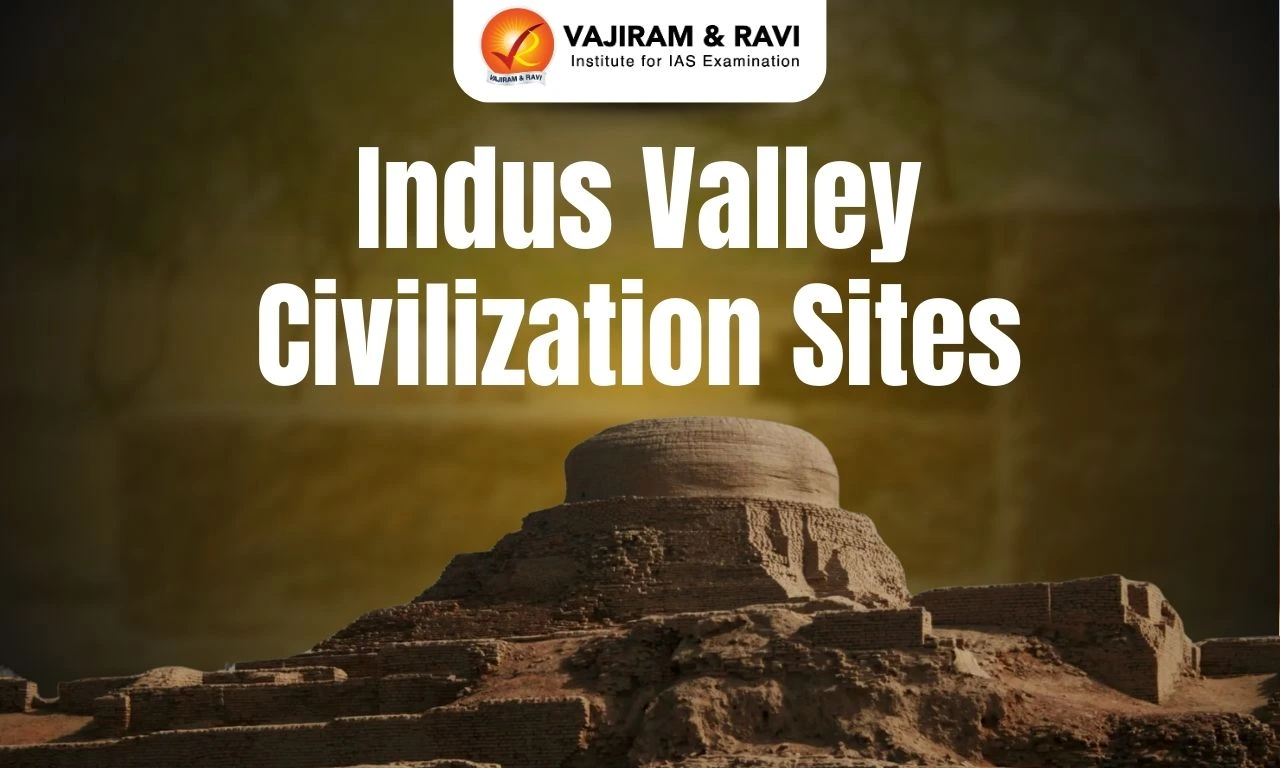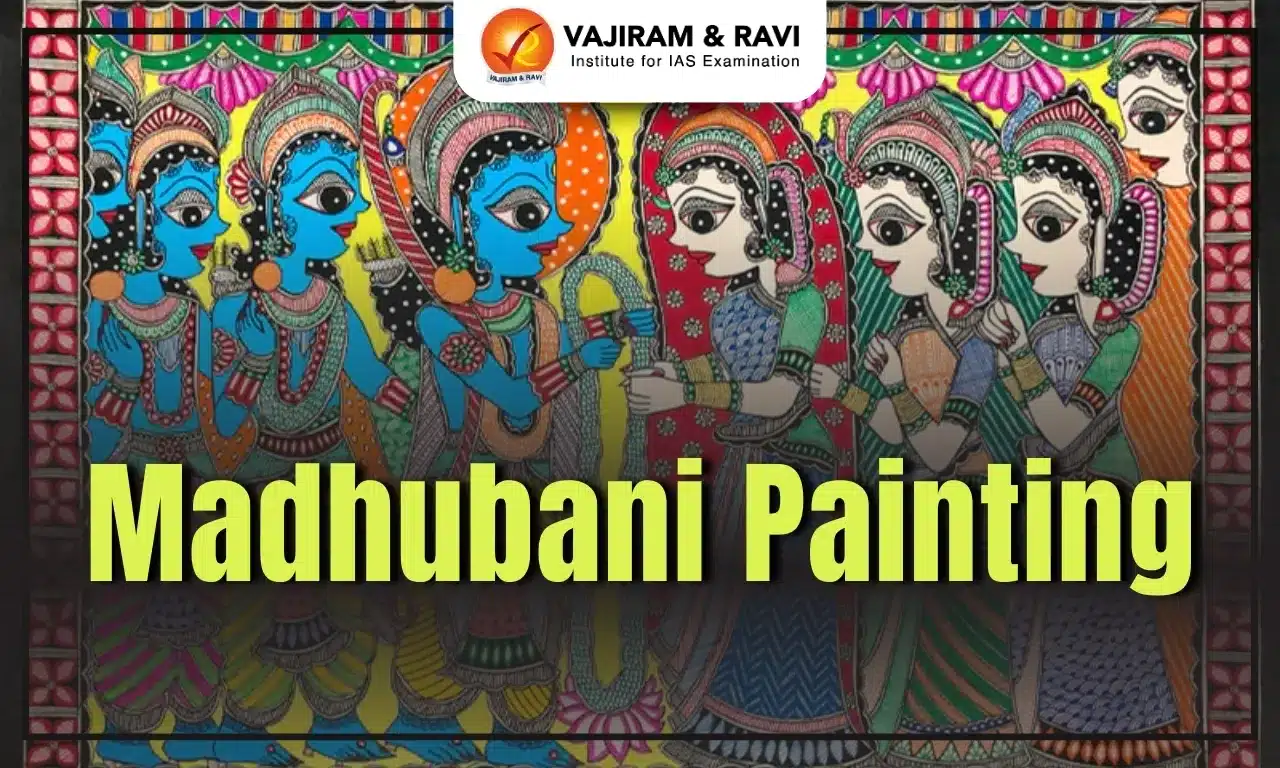The Indus Valley Civilization (IVC), also known as the Harappan Civilisation, is one of the earliest civilisations globally. It existed concurrently with the civilisations of Mesopotamia and Ancient Egypt.
The Indus Valley Civilization, located on the river basins of the Indus and Ghaggar-Hakra, featured several key cities, such as Mohenjodaro, Harappa, Kalibangan, Lothal, Rakhigarhi, Chanhudaro, and Dholavira.
About Indus Valley Civilization
The Indus Valley Civilization (IVC) was a Bronze Age civilisation that flourished in the northwestern regions of South Asia, primarily in present-day Pakistan and northwest India, around 3300 BCE to 1700 BCE and in its mature form from 2600 BCE to 1900 BCE.
- The IVC significantly influenced subsequent cultures and civilisations in the Indian subcontinent.
- Its advancements in urban planning, architecture, and social organisation remain subjects of admiration and study in modern archaeology and history.
Major Sites of Indus Valley Civilisation
The IVC encompassed numerous significant sites, each contributing unique insights into the civilisation’s urban planning, culture, and economy. Following are some of the key sites and their significance:
Harappa
Harappa, a city of the IVC, existed from 2600 BCE to 1900 BCE. Daya Ram Sahni excavated the Harappa siteon the bank of the Ravi River.
- Architecture: The town was laid out on a grid plan and had several impressive public buildings, including a granary and a citadel. The city of Harappa was divided into two parts: the citadel and the lower town.
- Drainage: Harappa has provided evidence of elaborate drainage facilities in the Indus Valley civilisation. It was found that the street drains were made of baked bricks.
- Pottery: Redware pottery is the most common type of pottery in Harappan cities. It features painted designs with geometric patterns such as horizontal lines, circles, pipal leaves, plants, and trees, as well as fish and peacock motifs.
- Seal-making: There is evidence of shell-making workshops in Harappa. Seals depict various animals, such as short-horned bulls, buffalo, rhinoceros, tigers, and crocodiles.
- Weights and measures: Scales made of shell, ivory, and copper were found in Harappa and were probably used for linear measurement.
- Granary: The ‘granary’ was located in the citadel. It consisted of 12 units organised in 2 rows of 6 rooms, separated by a central passage.
- Burials: There is evidence of coffin burials, which were found only in Harappa. Wooden coffins were also found at Harappa.
Mohenjodaro
Mohenjo Daro, also known as the “Mound of the Dead,” is a collection of mounds and ruins located on the right bank of the Indus River in northern Sindh province, Pakistan. It thrived between 2600 and 1900 BCE. Significant Findings at Mohenjodaro include the following:
- Great Bath: Mohenjo-Daro’s famed structure, the Great Bath, is a 612-meter-long brickwork marvel with a tank measuring 11.88×7.01 meters and 2.43 meters deep. Water is sourced from a well, and the building has a bituminised floor and walls to prevent leaks and open porches on four sides.
- Granary: The greatest discovery at Mohenjo-Daro is a granary with 27 chambers of varying sizes and shapes.
- Assembly Hall: Another key structure, the Assembly Hall, a 90×90 feet pillared hall, served as a social meeting place in the citadel.
- Lower Town: The lower town featured large courtyard buildings, indicating a significant middle class.Each home in Mohenjo-Daro included a courtyard, kitchen, and well with ample light and drainage. Small bathrooms and efficient drainage and sanitation systems were common.
- Notable Artefacts: Ivory, lapis, carnelian, and gold beads, along with baked-brick city buildings, showcase the city’s wealth and importance.
- Mother Goddess: A captivating figure from the Indus Valley Civilization, the ‘Mother Goddess’ terracotta sculpture is handmade, originating in Mohenjo Daro, Pakistan, around 2500 BCE.
- Priest-King: The ‘Priest-King’ is a steatite sculpture found at Mohenjo-Daro, featuring a bearded man with distinctive features and a trefoil-carved cloak.
- Dancing Girl: A famous bronze sculpture from Mohenjo-daro, the ‘Dancing Girl,’ created using the lost-wax casting method, stands out as the city’s most prominent figurative artwork.
- Pashupati Seal: The ‘Pashupati Seal,’ a steatite seal, depicts a cross-legged figure surrounded by animals. Interpretations vary, with some seeing a yogi and others a three-headed “proto-Shiva” ruling over animals.
Dholavira
Dholavira, known as Kotada in the local dialect,was a 1,200-year-old Harappan city that was inhabited between 3000 and 1800 BCE.
- Location: Dholavira, located near the village of Dholavira in Gujarat’s Kutch District, is the fifth-largest Indus Civilization site in the subcontinent and was designated a UNESCO World Heritage Site in 2021. It is situated between the Mansar and Manhar seasonal streams.
- Features: The site includes a walled city with a fortified Castle, Bailey, Ceremonial Ground, Middle Town, and Lower Town, as well as a cemetery to the west. East and south of the Citadel, a series of reservoirs were discovered.
- Archaeological Findings: Dholavira’s remains feature fortifications, gateways, water reservoirs, ceremonial grounds, residential units, workshop areas, and a cemetery, all indicative of Harappan culture.
- Water System: The sophisticated water system includes 16 reservoirs, water channels, and step wells leading to large public baths.
Kalibangan
The name Kalibangan is derived from two words: Kali and Bangan. Kali means black, and Bangan means bangle. The numerous pieces of terracotta bangles that were discovered here led to the naming of Kalibangan.
- Location: It is located about 310 kilometres northwest of Delhi, along the left bank of the now-dry river Ghaggar in the Hanumangarh district of Rajasthan
- Features: Kalibangan is significant for its archaeological evidence of both the pre-Harappan period and the Harappan period.
- Kalibangan served as the primary provincial capital of the Indus Valley Civilisation.
- It is well-known for its remarkable fire altars, which show evidence of animal sacrifice.
- It also provides the world’s earliest evidence of ploughed fields, irrigation, and fertiliser use.
- The presence of trepanned skulls at Kalibangan suggests that the IVC people had a considerable understanding of human anatomy and surgical techniques.
Lothal
The name “Lothal,” derived from the combination of “Loth” and “(s) thal” in Gujarati, translates to “the mound of the dead.”
- Location: Lothal, situated in Gujarat, was one of the southernmost sites of the IVC. The port city is believed to have been constructed around 2,200 BC.
- Features: Lothal housed the world’s earliest known dock, linked to the Sabarmati River, crucial for trade between Harappan cities and Saurashtra. Marine microfossils, salt, and gypsum crystals found by the National Institute of Oceanography confirm it was a dockyard.
- The Archaeological Survey of India excavated a mound, township, marketplace, and the dock itself.
Rakhigarhi
Rakhigarhi is one of the five largest known townships of the Harappan civilisation on the Indian subcontinent. In 2012, the watchdog GlobalHeritageFund listed it as one of the ten mostendangeredheritagesites in Asia. Rakhigarhi is among the five iconic sites announced in the Union Budget 2020, and Rakhigarhi Museum will be the world’s largest museum dedicated to Harappan culture.
- Location: Rakhigarhi, located about 150 km northwest of Delhi in Haryana’s Hisar District, is both a village and an important Indus Valley Civilization site.
- Major Findings: Excavations revealed that Harappans did not have steppe pastoral or ancient Iranian farmer ancestry. Seal impressions indicate they used seals to mark belongings. Artifacts like tools, jewellery, stamps, and weights suggest a toy culture and standardized weight systems.
Chanhudaro
Situated barely 130 kilometres away from Mohenjodaro, Chanhudaro, which dates back to the third millennium BCE, was a significant industrial centre that produced carnelian beads, which were highly valued in antiquity. The major findings of Chanhudaro include the following:
- Artefacts: Baked bricks were extensively utilised in the construction of homes in Chanhudaro.In Chanhudaro, evidence of shell works was unearthed, and the production of bangles and ladles took place.
- Seals: Harappan seals, integral to the administrative network, were crafted in larger towns like Harappa, Mohenjo Daro, and Chanhudaro.
- Evidence of Factories: Chanhu Daro has yielded evidence of factories manufacturing a diverse range of items such as figurines, seals, toys, and bone instruments. This suggests that it was not just a village but rather an industrial town with a significant number of skilled craftsmen.
Other Important Sites of Indus Valley Civilization
Other important sites, such as Surkotada and Banawali, reveal further aspects of their technological innovations, economic activities, and social organisation:
- Sutkagendor: This Harappan site is located in the Makran district of Balochistan (Pakistan), on the banks of the Dasht River.
- Presently, it is the westernmost site of the Harappan Civilization that is known. Like most Harappan sites, Sutkagendor also has a citadel and defensive wall that is about 30 feet wide.
- Significant archaeological findings unearthed from Sutkagendor include Stone vessels, Pottery, Shell beads and Bangles made out of clay.
- Surkotada: Situated on the banks of the Shadi Kaur river in Gujarat’s Kutch district, Surkotada is the sole Harappan site where tangible remnants of horse bones have been discovered.
- Evidence suggests that the Harappans settled this site only during the later phase of their civilisation, between 1900 BC and 1300 BC.
- Significant archaeological findings from Surkotada include horse, elephant, and wolf bones, as well as stone fortifications.
- Banawali: It is located in the Fatehabad district of Haryana, about 120 km northeast of Kalibangan.
- The city is made up of a well-built fort town with a 4.5-meter-tall defence wall. The houses were constructed using burnt and moulded brick kilns.
- Finding: Pottery, beads, seals, and evidence of trade with distant regions, indicating an advanced economy
- Amri: This site is located in the Dadu district of Sindh, Pakistan, on the banks of the Indus River. It has evidence of Antelopes and Rhinoceros.
Indus Valley Civilisation Sites UPSC PYQs
Question 1: Which one of the following ancient towns is well-known for its elaborate system of water harvesting and management by building a series of dams and channelling water into connected reservoirs? (UPSC Prelims 2021)
(a) Dholavira
(b) Kalibangan
(c) Rakhigarhi
(d) Ropar
Ans: (a)
Question 2: Which one of the following is not a Harappan Site? (UPSC Prelims 2019)
(a) Chanhudaro
(b) Kot Diji
(c) Sohagaura
(d) Desalpur
Ans: (a)
Question 3: Match List-I (Ancient site) with List-II (Archaeological finding) and select the correct answer using the codes given below the lists: (UPSC Prelims 2002)
| List-I (Ancient site) | List-II (Archaeological finding) | ||
| A | Lothal | 1 | Ploughed Field |
| B | Kalibangan | 2 | Dockyard |
| C | Dholavira | 3 | Terracotta replica of plough |
| D | Banawali | 4 | An inscription comprising ten large-sized signs of the Harappan script |
(a) A – 1; B – 2; C – 3; D – 4
(b) A – 2; B – 1; C – 4; D – 3
(c) A – 1; B – 2; C – 4; D – 3
(d) A – 2; B – 1; C – 3; D – 4
Ans: (b)
Last updated on April, 2025
→ UPSC Notification 2025 was released on 22nd January 2025.
→ The UPSC Vacancy 2025 were released 1129, out of which 979 were for UPSC CSE and remaining 150 are for UPSC IFoS.
→ As per UPSC Notification, the last date to apply is 18th February 2025.
→ The UPSC Prelims 2025 is scheduled to be conducted on 25th May 2025 and UPSC Mains 2025 will be conducted on 22nd August 2025.
→ Apply once through it and aspirants can apply for various government exams conducted by UPSC.
→ The UPSC Selection Process is of 3 stages-Prelims, Mains and Interview.
→ UPSC Result 2024 is released with latest UPSC Marksheet 2024. Check Now!
→ UPSC Toppers List 2024 is released now. Shakti Dubey is UPSC AIR 1 2024 Topper.
→ Also check Best IAS Coaching in Delhi
Indus Valley Civilisation Sites FAQs
Q1. What are the main sites of Indus Valley civilisation?+
Q2. Which is the largest Indus Valley civilization site?+
Q3. What was the first site discovered in the Indus Valley civilization?+
Q4. What is the smallest Harappan site?+
Q5. What is the latest site found in Indus Valley civilization?+















